About this Document
This connection and install guide is intended for an authorized and qualified service person who needs to safely rack mount and install a DDC Nodegrid Serial Console Plus (NSCP) in a rack.
After you have completed the installation in this guide, refer to the Nodegrid User Guide for details on how to further configure NSCP.
Verify the NSCP Part Number
Check the part number of the shipment against the device. Part Numbers can be found either on the box containing the unit or underneath the appliance on the product label. The following are the part numbers covered by NSCP.
NSCP-T16R-STND-DDC
NSCP-T32R-STND-DDC
NSCP-T48R-STND-DDC
NSCP-T96R-STND-DDC
List of Components and Accessories
Component | Included in the Box | Quantity | Description |
|---|---|---|---|
NSCP DDC Appliance | Yes | 1 | - |
Rack Mount Ears and Screws | Yes | 2 | - |
Console Cable | No | 1 | - |
DC Cables (4m) | No | 1-2 | 1 x cable is required for single DC usage |
Ground Cable (4m) | No | 1 | |
Screwdriver | No | 1 | This component is not supplied. |
Velcro Strips | No | 10+ | These components are not supplied. |
Warnings and Cautions
Read all the following safety guidelines before proceeding with the connections to protect yourself and your NSCP.
WARNINGS:
Do not operate the ZPE Systems Nodegrid Serial Console Plus with the chassis cover removed.
This is a Class A product. It may cause radio interference in a domestic environment, requiring appropriate measures.
Ensure the power source meets the DC power requirements of your Nodegrid Serial Console Plus. Verify the power source type and the condition of DC power cables before use to avoid personal injury or equipment damage.
Be cautious when wiring to a DC supply, especially in telecom racks, where the positive wire (usually blue) is grounded, and the hot wire (usually brown) carries -48VDC.
Installation must be performed by a certified and trained electrician. Incorrect installation can result in personal injury or equipment damage.
Always power off the unit using the power safety switch provided by the power source. Do not use the unit's power switch to turn it on or off.
The unit must be correctly grounded using the provided options. Failure to do so may result in the unit being grounded through personnel who touch it, posing a danger to human safety.
CAUTIONS:
To avoid shorting out your ZPE Systems Nodegrid Serial Console Plus when disconnecting the network cable, first unplug the cable from the Host Server, unplug external power (if applicable) from the equipment and then unplug the cable from the network jack. When reconnecting a network cable to the back of the equipment, first plug the cable into the network jack and then into the host server equipment.
To help protect the ZPE Systems Nodegrid Serial Console Plus from electrical power fluctuations, use a surge suppressor, line conditioner, or uninterruptible power supply. Ensure that nothing rests on the cables of the console server and that they are not located where they can be stepped on or tripped over.
Do not spill liquids on the console server. Such action can cause electrical shock or damage to the device
Nodegrid Serial Console Plus may reboot with a surge of -2kV at the input power.
Do not push any objects through the openings of the ZPE Systems Nodegrid Serial Console Plus. Doing so can cause fire or electric shock by shorting out interior components.
Keep your ZPE Systems Nodegrid Serial Console Plus away from heat sources and do not block the host’s cooling vents.
The ZPE Systems Nodegrid Serial Console Plus DC models are to be installed with a maximum 20A-listed circuit breaker or branch-rated fuse.
The ZPE Systems Nodegrid Serial Console Plus DC powered models are only intended to be installed in restricted access areas (dedicated equipment rooms, equipment closets, or the like) accordance with Articles 110-18, 110-26 and 110-27 of the National Electrical Code, ANSI/NFPA 701, 1999 Edition.
Minimum Specific Breaker or Fuse Rating: 6A. Required conductor size: 18 AWG or 0.75 mm2 or above. Fuses must be provided with unambiguous cross-references to servicing instructions (F1).
To reduce the risk of fire, use only No. 26 AWG or 0.14mm2 or larger UL Listed or CSA Certified Telecommunication Line Cord (for example, 24 AWG or 0.25mm2).
Descriptions and Specifications
This section summarizes the physical and environmental specifications of the NSCP device.
Device Overview
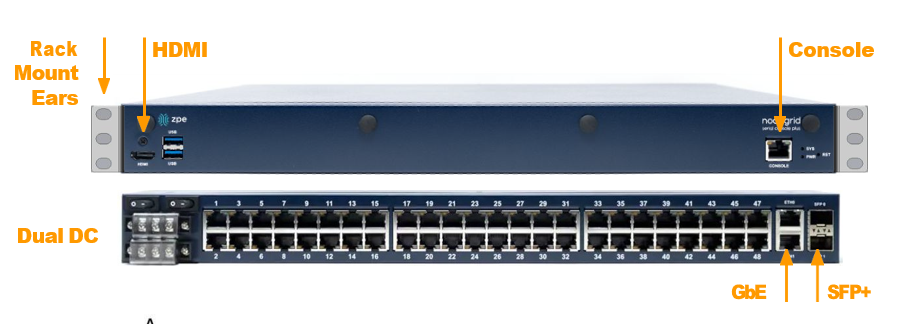 Physical
Physical
Front-Rear Mounting Brackets
Size (L X W X H): 443 X 312 X 43 mm (17.4 X 12.3 X 1.7 in), 1U
Weight: 5.265 kg (11.6 lb), depending on options
Shipping Weight: 8.745 kg (19.3 lb)
Shipping (L X W X H): 533 X 497 X 209 mm (21 X 19.6 X 8.3 in)
Environmental
Operation: -20 to 55° C (32ºF to 140° F), 5-95% RH, non-cond
Storage: -20 to 67° C (-4ºF to 153° F), 5-95% RH, non-cond
Power Specifications
40V-63 VDC dual power input (redundant)
Power consumption 45 W typical
Power Connection Details - Breaker Specification
Maximum Specific Breaker or Fuse Rating 20A-listed circuit breaker or branch-rated fuse.
Minimum Specific Breaker or Fuse Rating: 6A.
Required conductor size: 18 AWG or 0.75 mm or above.
Fuses must be provided with unambiguous cross-references to servicing instructions.
Power Module
The NSCP DDC devices are all equipped with a dual power supply for redundancy. Each terminal block has three terminal connections, which are covered by plastic protection and can be slid to either side to gain access to the connections.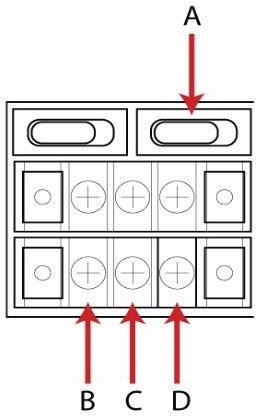
Key | Description |
|---|---|
A | Power Switch |
B | RTN (Return) |
C |
|
D | 48 VDC |
In case only a single power supply will be used to operate the appliance it is recommended to use Power Supply B.
The NSCP DDC units can be powered by voltage ranging from +-40 to +-63VDC.
For +VDC power sources:

Key | Power Supply | Marking on Unit | Description |
|---|---|---|---|
A1 | 1 | - | Power On and Off switch |
A2 | 1 | RTN | RTN (Return) - Represent the - (minus) feed, represented by the color white |
A3 | 1 |
| Ground |
A4 | 1 | 48 V | +48 VDC - Represent the + (plus) feed, which is represented by the color red |
B1 | 2 | - | Power On and Off Switch |
B2 | 2 | RTN | RTN (Return) - Represent the - (minus) feed, represented by the color white |
B3 | 2 |
| Ground |
B4 | 2 | 48 V | +48 VDC - Represent the + (plus) feed, which is represented by the color red |
For -VDC power sources:

Key | Power Supply | Marking on Unit | Description |
|---|---|---|---|
A1 | 1 | - | Power On and Off switch |
A2 | 1 | RTN | RTN (Return) - Represent the + (plus) feed, which is represented by the color red |
A3 | 1 |
| Ground |
A4 | 1 | 48 V | -48 VDC - Represent the - (minus) feed, represented by the color white |
B1 | 2 | - | Power On and Off Switch |
B2 | 2 | RTN | RTN (Return) - Represent the + (plus) feed, which is represented by the color red |
B3 | 2 |
| Ground |
B4 | 2 | 48 V | -48 VDC - Represent the - (minus) feed, represented by the color white |
DC Cable Requirements
The cables connecting the NSCP DDC must conform to local electrical, fire, and other security regulations. The requirements provided here are used as a guideline for the customer and do not replace existing rules.
IMPORTANT
The cable-specific requirements, like bending radius, must be confirmed with the cable vendor.
The cables should be terminated on the Nodegrid side with a ring terminator to avoid unintended disconnection from the terminal block. The Terminal ring size should correspond to M3 (recommended) or M4 and must not exceed 6.6 mm in width.
Earth Cable Requirements
The cables connecting the NSCP DDC must conform to local electrical, fire, and other security regulations. The requirements provided here are used as a guideline for the customer and do not replace existing rules.
The ground cable can either be part of the DC cable, or a dedicated ground cable must be used. If a dedicated ground cable is used, it must be AWS6 or 4mm or larger in diameter.
The Terminal ring size should correspond to M3 (recommended) and must not exceed 6.6 mm for installation on the DC power block.

When a dedicated ground cable is used, it must be terminated with a ring terminator (M4), and the ground screw on the left-hand side of the Nodegrid appliance must be used to avoid unintended disconnection.
Grounding
WARNING
This equipment must be grounded. Never operate it without a suitably installed ground conductor. If you are uncertain whether suitable grounding is available, contact the appropriate electrical inspection authority or an electrician.
The NSCP DDC devices must be appropriately electrically grounded. The NSCP appliance offers the following grounding method:
DC units should be grounded using the appropriate ground connector on the side of the unit. The Screw must be tightened with a torque of 1.3 to 1.8 N-m. (Recommended)
DC units should be grounded using the appropriate ground pins from both terminal blocks.
WARNING
The installation of an NSCP DDC unit and the connection and any changes, which include the DC power supply, must be performed by a certified and trained electrician!
Device Installation
NSCP devices are designed to be installed into a data center rack. They must be installed into racks with appropriate cable management solutions. Racks offer various cable management options, and users can implement their specific cable management guidelines, such as side cable management options.
Read all the safety guidelines (WARNING and SAFETY Section) before proceeding with the connections to protect yourself and your Nodegrid Serial Console Plus.
The NSCP device cable management can be done using cable management solutions provided by the rack manufacturer and directly integrated into the rack, or device cable management can be performed by adding cable management solutions like lacing bars.
This guide will only outline a validated installation into a rack with a built-in cable management solution. The solution must provide cable management options on the left side of the unit. Additional cable management options can be provided as long as they do not impede the cable management on the left.
IMPORTANT
Appropriate cable management is an integral part of correctly using and installing the provided DC equipment. There is no “one“ proper way of performing cable management; therefore, some judgment must be made. At the core, cable management must fully support the following functions.
avoid any trip hazards, accidental and through negligence
avoid the accidental disconnection of connections or cables
provide a safe work environment
Installation
Users may decide to implement their own guidelines, but the following general requirements must be observed for the installation of NSCP DDC:
Leave enough space above and below the unit; having a minimum of 1U is recommended.
Observe the minimum bending radius for the used power cable for non-motion.
For example, the cables with a 6.9 mm and 4.1mm diameter have a typical non-moving minimum bending radius of 35 mm. The cable should be attached to the unit with the provided screws and a torque of 1.3 to 1.8 N-m.
IMPORTANT
Check the cable specification before the installation for cable-specific details.
Affix the DC power cables to an appropriate mounting facility provided by the rack.
DC power cables should be guided to the left side and console cables to the right, separating power and other passive cabling clearly.
Rack Mount and Cable Management
WARNING:
Installation must be performed by a certified and trained electrician. Incorrect installation can result in personal injury or equipment damage.
Always power off the unit using the power safety switch provided by the power source. Do not turn the unit's power switch on or off.
The unit must only be operated with the plastic covers, protecting the DC connectors in place
The unit must be correctly grounded using the provided options. Failure to do so may result in the unit being grounded through personnel who touch it, posing a danger to human safety.
Attach ear mounts from the NSCP accessory box using the Phillips #2 screwdriver and provided screws to the unit.
Select an appropriate rack space with enough space above and below to install the unit safely. The recommended minimum is 1 RU above and below.
Install the cage nuts.
Connect the ground cable to the appliance using the available ground screw on the left-hand side. The cable should be attached to the unit with the provided screws and a torque of 1.3 to 1.8 N-m as shown in the following example diagrams.
.jpeg)
Install the NSCP unit with the power outlets and console connection facing the installer.
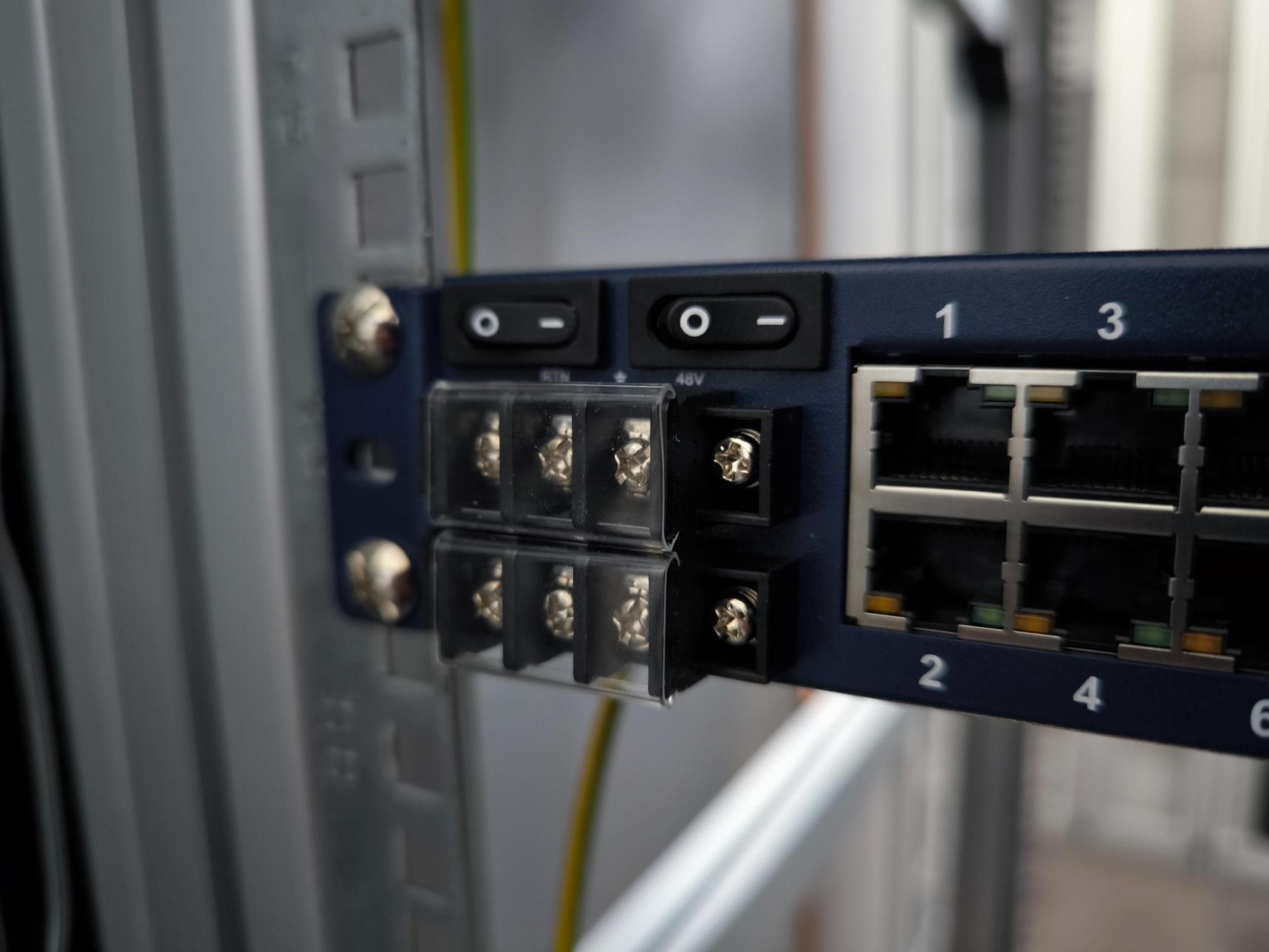
Connect the Ground Cable to an appropriate ground.
IMPORTANT:
Validate the appropriate grounding of the device using an Ohm/Volt meter or other suitable tools before continuing.
The NSCP DDC appliance requires appropriate space above and below the unit to connect and install the DC power cables safely.
For a Dual DC power supply, the unit must have space above and below the unit for safe installation.
For a Single DC power supply, power supply B must be used, and a minimum space of 1U below the unit is required.
Bending Radius: For example, the cables have a minimum bending radius of 35 mm for the cable and 12 mm for a single wire. The minimum bending radius indicates that the cable can not be bent any further.
The DC cables must be inserted from the top and bottom and be led to the left-hand side of the unit.
WARNING:
Ensure that the cables are not connected to any active power source when connecting them to the NSCP DDC unit. Always power off the unit using the power safety switch provided by the power source. Do not turn the unit's power switch on or off.
The unit must be correctly grounded using the provided options. Failure to do so may result in the unit being grounded through personnel who touch it, posing a danger to human safety.
Do not exceed the maximum bending radius for the cables during installation. Check with the cable manufacturer for the allowed bending radius.
Never touch the connectors while the DC power source operates. Contact with live connectors may cause electrical shock or damage the equipment.
Terminate cables with round connectors to prevent accidental disconnections and reduce tripping hazards.
INFORMATION
For a safe installation, follow these guidelines when routing cables through rack installation:
Secure cables using flexible, reusable straps or other mechanisms to ensure they are firmly held and cannot be easily moved.
Secure the cables every 40cm or less
Secure the cables as close as possible on each side to the power connection.
Connect NSCP to DC Power Source
IMPORTANT
Always follow local health and safety regulations, especially when working on electrical power lines.
WARNING:
The installation of an NSCP DDC unit and the connection and any modifications, which include the DC power supply, must be performed by a certified and trained electrician!
Make sure both power switches on NSCP are turned ON. The power switch flipped to the right indicates the default setting.

WARNING:
Ensure the cables are not connected to any active power source when connecting them to the NSCP DDC unit. Always power off the unit using the power safety switch provided by the power source. Do not turn the unit's power switch on or off.
Make sure the DC main power source is turned off.
WARNING:
Never work on powered (hot) wires.
All DC Power Installation options
Using Power Supply B, remove the protective cover on the DC terminals. (Slide to the left or right to remove.):
.jpeg)
Loosen all DC power connection terminal screws.
For +48VDC power sources:
1. If the unit is earthed through the terminal block, using an integrated cable, first connect the earth cable to the middle connector, which is marked with the ground symbol.
2. Connect the return cable (white) to the RTN terminal on NSCP.
3. Connect +48 VDC cable (red) to the 48 VDC terminal on NSCP.For -48VDC power sources:
If the unit is earthed through the terminal block, using an integrated cable, first connect the earth cable to the middle connector, which is marked with the ground symbol.
Connect the -48VDC cable (red) to the RTN terminal.
Connect the return cable (white) to the 48 VDC terminal.
Tighten the screws back to each terminal with a torque of 1.3 to 1.8 N-m.
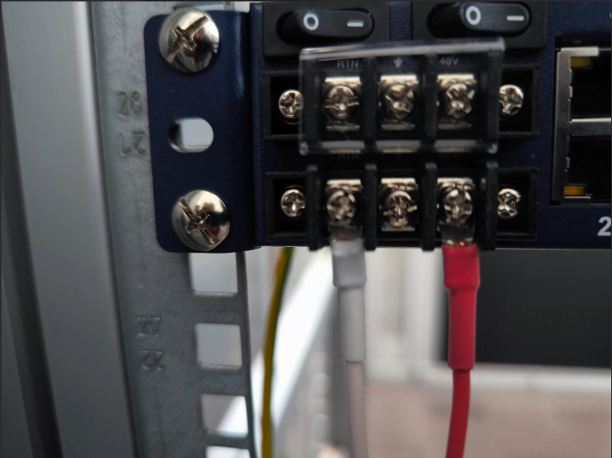
Slide the DC terminal block protective cover back into place.
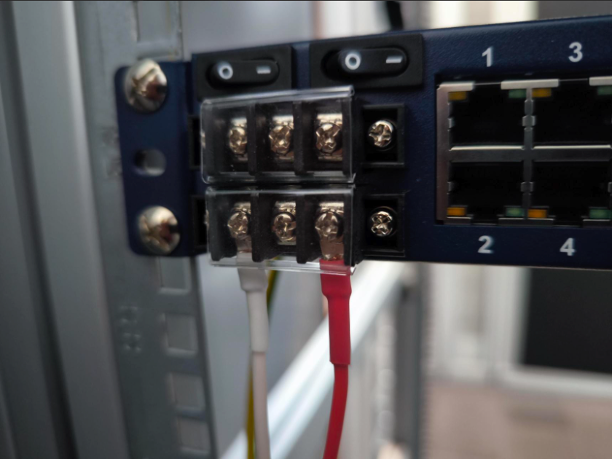
Run the power cables to the left side of the unit, observing a minimum bending radius of 35mm.
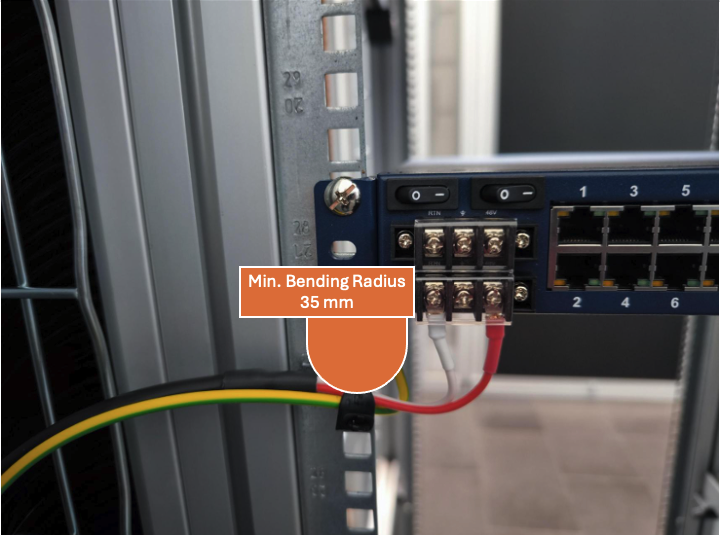
CAUTION:
Ensure the cable is not bent too tightly and follows the minimum bending radius.
Dual DC Power Installation ONLY
Starting with Power Supply A, remove the protective cover on the DC terminals. (Slide to the left or right to remove.):
Loosen all DC power connection terminal screws.
For +48VDC power sources:
1. If the unit is earthed through the terminal block, using an integrated cable, first connect the earth cable to the middle connector, which is marked with the ground symbol.
2. Connect the return cable (white) to the RTN terminal on NSCP.
3. Connect +48 VDC cable (red) to the 48 VDC terminal on NSCP.For -48VDC power sources:
If the unit is earthed through the terminal block, using an integrated cable, first connect the earth cable to the middle connector, which is marked with the ground symbol.
Connect the return cable (white) to the 48 VDC terminal.
Tighten the screws back to each terminal with a torque of 1.3 to 1.8 N-m.
Slide the DC terminal block protective cover back into place.
Run the power cables to the left side of the unit, observing a minimum bending radius of 35mm.
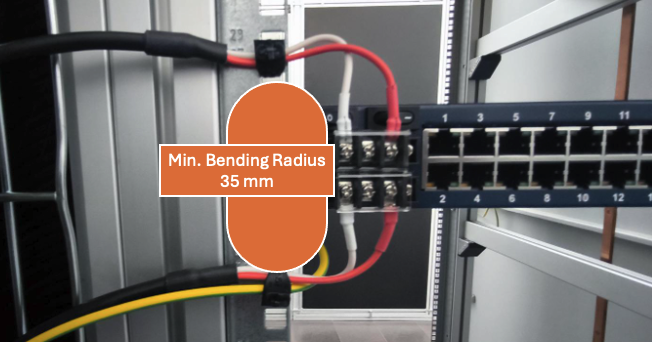
CAUTION:
Ensure the cable is not bent too tightly and follows the minimum bending radius.
Finish Installation for all units
Using a flexible cable strip, affix both cables as close as possible to the terminal block to the cable management system.
The cables must be fixed to the cable management every 40 cm (1.3 feet) or less to avoid accidental movement and provide appropriate cable relief.
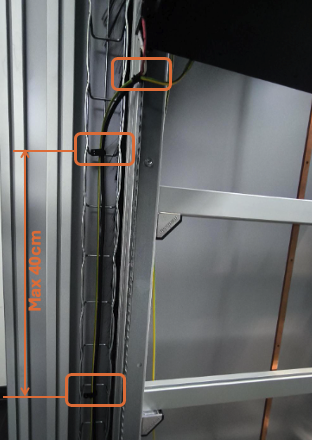
Double-check that the DC power source is off, then connect the power cables to the power source, connecting Power Supply A first (if applicable), then Power Supply B
If required for local configuration, connect any other cables to the appliance, such as device console cables, network cables, and a device console cable.
Turn on both DC power sources.
WARNING:
Before continuing, ensure that the unit is properly connected to its power source and that it works as expected to ensure a secure operation of the unit.
The unit must be correctly grounded using the provided options. Failure to do so may result in the unit being grounded through personnel who touch it, posing a danger to human safety.
The unit will power on and boot up.
Connect the console cable to a laptop or other applicable device.
Open a terminal program and connect to the serial console port using the settings 115200, 8, N, 1, N
The console connection will display the boot process until the unit is fully booted and a login prompt is displayed.
The unit is now ready to be configured; see the Nodegrid User Guide at https://docs.zpesystems.com.
 (Ground)
(Ground)
